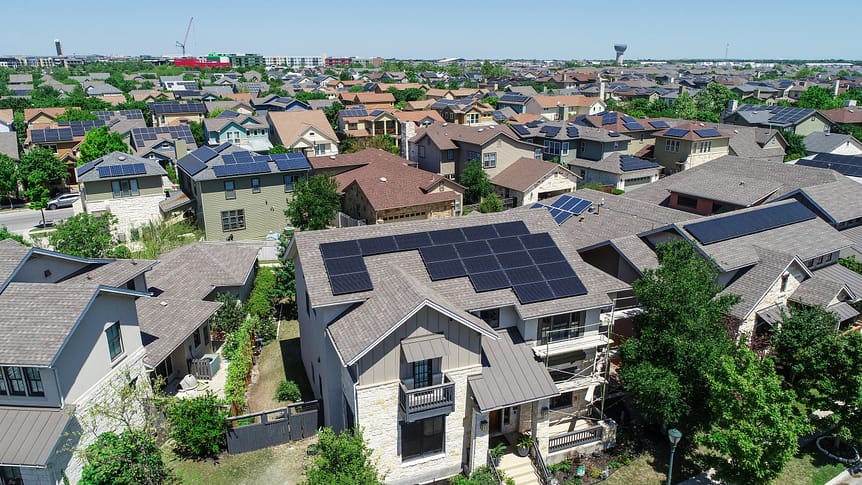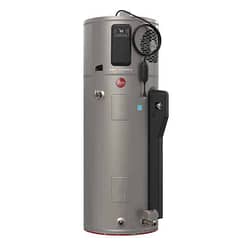Making Their Way to the Mainstream
National building codes will soon mandate some of today’s now-voluntary practices in building net zero, carbon neutral homes. The latest 2021 IECC code exceeds the current Department of Energy ZERH (Zero Energy Ready Home) program requirements. And it serves as the baseline in the forthcoming 2024 program requirements.

Building Products & Practices Raise the Bar Toward Net Zero
New homes implementing the latest products and practices are significantly more energy efficient that older homes. And homes meeting the ZERH guidelines promise even more. Net zero homes produce as much energy as they consume over the course of a year.
High-quality products used in new Texas homes minimize heat transfer and maintain indoor temperatures. This includes insulation materials such as foam, fiberglass, or cellulose. Energy-efficient windows featuring multiple panes, low-emissivity coatings, and insulated frames are also an important part of the net zero or ZERH energy equation.
Texas builders often frame houses with two-by-six-inch lumber rather than two-by-fours to achieve better wall insulation values. Builders have also learned the benefits of creating unvented attic spaces by applying spray-foam insulation at the roof rafters. HVAC equipment and ductwork placed inside the conditioned space of an unvented attic substantially improves new home energy performance.
Energy-saving LED lighting is now a standard for new home construction in Texas. And modern appliances save on both energy and water. The integration of smart thermostats, automated lighting systems, and energy management apps provide real-time data allowing users to adjust settings for maximum energy efficiency. ZERH solar panels that generate electricity from renewable resources work to offset energy consumption and help achieve homes achieve net zero goals.
New HVAC Equipment Is More Efficient, Smarter
Variable-speed motors, energy recovery ventilation, and smart thermostats are some of the options for new heating, ventilation, and air conditioning (HVAC) equipment. A high SEER (Seasonal Energy Efficiency Ratio) rating for cooling and a high AFUE (Annual Fuel Utilization Efficiency) rating for heating indicate greater energy efficiency and lower energy consumption.
But it is critical that the HVAC system be right-sized for optimum comfort and performance. Bigger is not always better! For example, a super-efficient wall system can reduce the AC load level needed. Oversized air conditioners tend to short-cycle, meaning they power up and down throughout the day many more times than units that cycle properly. This needlessly uses up energy and shortens the equipment lifespan.
Allison Bailes of Energy Vanguard will be one of the presenters for DFW Building Science Day. Learn more/ register for this event.
Read his posts:
5 Tips for Sizing an Air Conditioner
How Many Tons of Air Does Your HVAC System Move?
3 Reasons Your 3 Ton Air Conditioner Isn’t Really 3 Tons
Why Is Air Conditioner Capacity Measured in Tons?

Heat pumps are an increasingly popular alternative to traditional HVAC equipment.
Air source heat pumps deliver one to three times more energy than the electricity they consume. That’s because instead of generating heat, heat pumps move heat by transferring it between the indoors and outdoors using a liquid refrigerant and copper coils. A heat pump system is basically an all-in-one unit that functions as both the central heat and AC systems in your home. Multi-zone installations can have two or more indoor heads connected to one outdoor condenser. Heat pump water heaters use the same process by pulling heat from the outside air and transferring it at higher temperatures to heat water in a storage tank.
Geothermal systems, or ground sourced heat pumps, are another type of heat pump that utilizes underground pipes to transfer heat to or from the earth. The stable temperature of the ground heats and cools the house. CoHousing Houston is the first planned community development in Harris County to install a geothermal heat exchange system. The “networked geothermal” concept connects of a number of ground-source heat pumps to one another. Forming a shared loop network brings significant cost savings to geothermal technology.
Energy Raters Now Essential to the New Home Construction Team
The owners of newly constructed homes benefit from the oversight that home energy raters provide. Home energy raters are uniquely trained and certified to provide energy efficiency strategies designed to maximize the comfort of the home occupants. Raters use the nationally recognized Home Energy Rating System (aka the HERS index) to determine and verify a home’s energy performance.
Energy raters are also knowledgeable about using the Energy Rating Index (ERI) compliance path to assist builders wishing to attain energy certifications. ENERGY STAR or LEED (Leadership in Energy and Environmental Design) certifications are valuable in the marketing of new homes. They serve as a validation to indicate that a home is significantly more energy-efficient than required by minimum building codes. And of course, the rater can ensure that homes qualify for the DOE’s ZERH program. If and when ZERH standards become mandated by code, the energy rater’s role will be even more important.




Rebates Encourage Energy Efficiency Upgrades
Whether they’re considering upgrades for a new home they’re building or improvements to their existing homes, rebates incentivize consumers to make investments in saving energy or striving to achieve ZERH. Consumers can tap the 25C to take both an up-to-$2,000 tax credit for a qualifying heat pump and a $1,200 tax credit for insulation in the same year. A new whole home energy rebate program will be launched early next year. An income-qualified electrification rebate program is also forthcoming.
Builders, too, are incentivized by rebates. For the next ten years starting in 2023, the 45L tax credit will provide builders $5,000 for each single-family home and $1,000 for each multi-family unit certified to Zero Energy Ready Home (ZERH) requirements.
New Buyer Mindsets are the Primary Driver of Mainstream Change
Now that Millennials represent the majority among home buyers and Gen Zs are next, builders expect exponential growth in demand for net zero, connected, solar powered homes. Green Builder reports that since 2020, there has been a 190 percent growth in total homes voluntarily certified to zero energy and zero energy ready programs in the U.S. and Canada. This includes a 440 percent growth in single-family homes with over 67,000 certified units in 2022.
Top concerns of the new generation of home buyers are the environment and a desire for clean energy. And that will further the rise of Zero Energy homes to the mainstream. The key, however, is to deliver zero energy and still price the home within reach of the average homeowner.
Net Zero and Carbon Neutral Does Not Have to Mean Going All-Electric
The 88th Texas Legislature passed a bill prohibiting local governments from banning fuel sources. We’ve all heard about the movement to get rid of natural gas entirely. However, Construct Utopia reported on a new home development and research project in Illinois that challenges that. The project aims to demonstrate that natural gas can, in fact, be a part of the energy solutions for net zero, carbon neutral homes. The Smart Neighborhood project will test three different technology packages. The first will include high-efficiency gas heating. When modeled, this option was found to be the lowest-cost path to net zero for the climate zone. The second package will have a hybrid system with both a heat pump and a natural gas furnace backup. And the third will feature a new heat pump that uses natural gas.
Factory-Built Building Products Address Multiple Challenges

As the housing industry moves toward building homes that are net zero ready, there’s even more reason to rethink the traditional building envelope. Ideally, some of the extra cost for products manufactured in a factory will be recouped in time savings and labor costs for the builder. And the consumer will be able to see a quick pay-back from reduced utility bills
Many builders already use pre-manufactured structural components.
The superior dimensional accuracy is just one reason to consider factory-fabricated Structural Insulated Panels (SIPs) for wall and roof assemblies. SIPs panels are made using OSB or plywood skins pressed and glued to both sides of a foam panel. They come as large as 24 ft. x 9 ft.
This translates to significant labor time saved on the structure assembly. Most importantly, SIPs control air, thermal, and moisture flow. The resulting benefit is labor time and cost saved on insulating, air sealing and waterproofing.
Pre-fabrication makes it easier and more cost effective than ever to achieve quality, productivity, and sustainability.CertainTeed is the first building products manufacturer in the U.S. to offer prefab assembly for residential construction.
And now, there’s even a factory-built solution for home foundations!
Precast concrete foundations come with rigid foam insulation (typically R-10) installed along the interior face of their surface. This creates a complete thermal break assembly. The large foundation panels are produced offsite and installed in the field. The ribbed configuration of the panels requires 70% less concrete than a typical poured-in-place concrete foundation. And that’s environmentally significant since concrete is the biggest source of embodied carbon in homes. A metal channel covers the concrete ribs to allow attachment of the interior drywall without a framed wall. And last, the assembled panels act like an effective bond-beam and do not require a concrete footing. Meticulous field work to ensure a perfectly level gravel bed for the panels is still required. But the panels save much of the site time needed to assure level above-grade construction.
Mono Slab® EZ Form is a patented product that allows you to form, insulate and backfill all before you pour and place concrete. Mono Slab® EZ form removes several steps from the traditional forming and insulating process to save you time, labor and money.
Net-Zero Opens the Door for Manufactured Housing

Building prefabricated houses in a controlled factory environment allows for precise construction techniques and quality control. This can result in better insulation and reduced energy loss compared to traditional on-site construction. And off-site construction offers a solution to both the ZERH initiative and the home affordability crisis. Manufactured housing can save 20% on construction timelines. The potential to reduce material waste by more than 80% is more environmentally friendly. And it saves on construction debris haul-off fees. Despite the significant benefits of off-site construction, acceptance barriers exist. This includes varying state and local regulatory requirements and a lack of understanding of the off-site construction process.
Transcend Communities, a partnership between Green Builder Media and Dvele Homes, is out to prove that today’s pre-fab isn’t what you think. “This isn’t your grandfather’s prefab,” says Sara Gutterman, CEO of Green Builder Media. “This is more like a precision engineered car.” Transcend’s net-zero ZERH demonstration home built in the Dvele factory is installed in the San Juan mountains of Colorado.
See this SAVVY SPECIAL REPORT for more information about the prefabricated home industry.
THE BOTTOM LINE: The Texas Legislature passed SB 2453, allowing the state to make amendments to energy code. This may mean you won’t be subject to comply with national code mandates to build to net zero (ZERH) standards. But savvy builders will adopt at least some of the theories and practices. They’ll be ready to answer to the increasing number of buyers who seek net zero homes.
Related Reading:
Dallas HVAC Company Gets Majority Investment from New York-Based Firm. Investcorp, a global alternative investment firm, partners with Shearer Supply to capitalize on “strong secular tailwinds” in the HVAC industry and leverage the distributor’s one-stop-shop value proposition for contractors and OEMs.
Solar shingles and solar roof tiles resemble asphalt shingle roofs.
